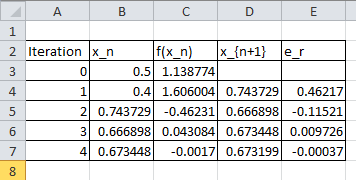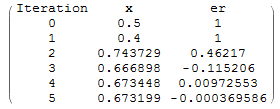Open Methods: Secant Method
The Method
The secant method is an alternative to the Newton-Raphson method by replacing the derivative ![]() with its finite-difference approximation. The secant method thus does not require the use of derivatives especially when
with its finite-difference approximation. The secant method thus does not require the use of derivatives especially when ![]() is not explicitly defined. In certain situations, the secant method is preferable over the Newton-Raphson method even though its rate of convergence is slightly less than that of the Newton-Raphson method. Consider the problem of finding the root of the function
is not explicitly defined. In certain situations, the secant method is preferable over the Newton-Raphson method even though its rate of convergence is slightly less than that of the Newton-Raphson method. Consider the problem of finding the root of the function ![]() . Starting with the Newton-Raphson equation and utilizing the following approximation for the derivative
. Starting with the Newton-Raphson equation and utilizing the following approximation for the derivative ![]() :
:
![]()
the estimate for iteration ![]() can be computed as:
can be computed as:
![]()
Obviously, the secant method requires two initial guesses ![]() and
and ![]() .
.
Example
As an example, let’s consider the function ![]() . Setting the maximum number of iterations
. Setting the maximum number of iterations ![]() ,
, ![]() ,
, ![]() , and
, and ![]() , the following is the Microsoft Excel table produced:
, the following is the Microsoft Excel table produced:

The Mathematica code below can be used to program the secant method with the following output:

f[x_] := Sin[5 x] + Cos[2 x];
xtable = {0.5, 0.4};
er = {1,1};
es = 0.0005;
MaxIter = 100;
i = 2;
While[And[i <= MaxIter, Abs[er[[i]]] > es], xnew = xtable[[i]] - (f[xtable[[i]]]) (xtable[[i]] - xtable[[i - 1]])/(f[xtable[[i]]] -f[xtable[[i - 1]]]); xtable = Append[xtable, xnew]; ernew = (xnew - xtable[[i]])/xnew; er = Append[er, ernew]; i++];
T = Length[xtable];
SolutionTable = Table[{i - 1, xtable[[i]], er[[i]]}, {i, 1, T}];
SolutionTable1 = {"Iteration", "x", "er"};
T = Prepend[SolutionTable, SolutionTable1];
T // MatrixForm
import numpy as np import pandas as pd def f(x): return np.sin(5*x) + np.cos(2*x) xtable = [0.5, 0.4] er = [1,1] es = 0.0005 MaxIter = 100 i = 1 while i <= MaxIter and abs(er[i]) > es: xnew = xtable[i] - (f(xtable[i]))*(xtable[i] - xtable[i - 1])/(f(xtable[i]) -f(xtable[i - 1])) xtable.append(xnew) ernew = (xnew - xtable[i])/xnew er.append(ernew) i+=1 SolutionTable = [[i, xtable[i], er[i]] for i in range(len(xtable))] pd.DataFrame(SolutionTable, columns=["Iteration", "x", "er"])
The following code runs the Secant method to find the root of a function ![]() with two initial guesses
with two initial guesses ![]() and
and ![]() . The value of the estimate and approximate relative error at each iteration is displayed in the command window. Additionally, two plots are produced to visualize how the iterations and the errors progress. The program waits for a keypress between each iteration to allow you to visualize the iterations in the figure. Call the function with secant(@(x) f(x), x0, x1). For example try secant(@(x) sin(5.*x)+cos(2.*x),0.5,0.4)
. The value of the estimate and approximate relative error at each iteration is displayed in the command window. Additionally, two plots are produced to visualize how the iterations and the errors progress. The program waits for a keypress between each iteration to allow you to visualize the iterations in the figure. Call the function with secant(@(x) f(x), x0, x1). For example try secant(@(x) sin(5.*x)+cos(2.*x),0.5,0.4)
Convergence Analysis of the Secant Method
The ![]() estimate in the secant method is obtained as follows:
estimate in the secant method is obtained as follows:
![]()
Multiplying both sides by -1 and adding the true value of the root ![]() where
where ![]() for both sides yields:
for both sides yields:
![]()
Using algebraic manipulations:
![Rendered by QuickLaTeX.com \[ \begin{split} x_t-x_{i+1}&=\frac{(x_t-x_i)(f(x_i)-f(x_{i-1}))+f(x_i)(x_i-x_{i-1})}{f(x_i)-f(x_{i-1})}\\ &=\frac{f(x_i)(x_t-x_{i-1})-f(x_{i-1})(x_t-x_i)}{f(x_i)-f(x_{i-1})}\\ &=(x_t-x_{i-1})(x_t-x_i)\frac{\frac{f(x_i)}{x_t-x_i}-\frac{f(x_{i-1})}{x_t-x_{i-1}}}{f(x_i)-f(x_{i-1})} \end{split} \]](https://engcourses-uofa.ca/wp-content/ql-cache/quicklatex.com-e9e56f81563b88b0e12826549f008699_l3.png)
Using the Mean Value Theorem, the denominator on the right-hand side can be replaced with:
![]()
for some ![]() between
between ![]() and
and ![]() . Therefore,
. Therefore,
![]()
Using Taylor’s theorem for ![]() and
and ![]() around
around ![]() we get:
we get:
![Rendered by QuickLaTeX.com \[\begin{split} \frac{f(x_i)}{x_t-x_i}=f'(x_t)+\frac{f''(\xi_1)}{2}{(x_t-x_i)}\\ \frac{f(x_i)}{x_t-x_{i-1}}=f'(x_t)+\frac{f''(\xi_2)}{2}{(x_t-x_{i-1})} \end{split} \]](https://engcourses-uofa.ca/wp-content/ql-cache/quicklatex.com-6775b5eb8381df36f43839b13b044c66_l3.png)
for some ![]() between
between ![]() and
and ![]() and some
and some ![]() between
between ![]() and
and ![]() . Using the above expressions we can reach the equation:
. Using the above expressions we can reach the equation:
![]()
![]() and
and ![]() can be assumed to be identical and equal to
can be assumed to be identical and equal to ![]() , therefore:
, therefore:
![Rendered by QuickLaTeX.com \[\begin{split} x_t-x_{i+1}&=(x_t-x_{i-1})(x_t-x_i)\frac{\frac{f''(\xi)}{2}{(x_t-x_i-x_t+x_{i-1})}}{f'(\zeta)(x_i-x_{i-1})}\\ &=(x_t-x_{i-1})(x_t-x_i)\frac{-f''(\xi)}{2f'(\zeta)} \end{split} \]](https://engcourses-uofa.ca/wp-content/ql-cache/quicklatex.com-83b9edce2f74284e04719ee652fa6041_l3.png)
(1) ![]()
Comparing the convergence equation of the Newton Raphson method with 1 shows that the convergence in the secant method is not quite quadratic. To find the order of convergence, we need to solve the following equation for a positive ![]() and
and ![]() :
:
![]()
Substituting into equation 1 yields:
![]()
But we also have:
![]()
Therefore: ![]() . This equation is called the golden ratio and has the positive solution for
. This equation is called the golden ratio and has the positive solution for ![]() :
:
![]()
while
![]()
implying that the error convergence is not quadratic but rather:
![]()
The following tool visualizes how the secant method converges to the true solution using two initial guesses. Using ![]() ,
, ![]() ,
, ![]() , and solving for the root of
, and solving for the root of ![]() yields
yields ![]() .
.
The following Mathematica Code was utilized to produce the above tool:
View Mathematica CodeManipulate[
f[x_] := x^3 - x + 3;
f[x_] := Sin[5 x] + Cos[2 x];
xtable = {-0.5, -0.6};
xtable = {0.35, 0.4};
er = {1, 1};
es = 0.0005;
MaxIter = 100;
i = 2;
While[And[i <= MaxIter, Abs[er[[i]]] > es], xnew = xtable[[i]] - (f[xtable[[i]]]) (xtable[[i]] - xtable[[i-1]])/(f[xtable[[i]]] -f[xtable[[i - 1]]]); xtable = Append[xtable, xnew]; ernew = (xnew - xtable[[i]])/xnew; er = Append[er, ernew]; i++];
T = Length[xtable];
SolutionTable = Table[{i - 1, xtable[[i]], er[[i]]}, {i, 1, T}];
SolutionTable1 = {"Iteration", "x", "er"};
T = Prepend[SolutionTable, SolutionTable1];
T // MatrixForm;
If[n > 3,
(LineTable1 = {{T[[n - 2, 2]], 0}, {T[[n - 2, 2]], f[T[[n - 2, 2]]]}, {T[[n - 1, 2]], f[T[[n - 1, 2]]]}, {T[[n, 2]], 0}};
LineTable2 = {{T[[n - 1, 2]], 0}, {T[[n - 1, 2]], f[T[[n - 1, 2]]]}}), LineTable1 = {{}}; LineTable2 = {{}}];
Grid[{{Plot[f[x], {x, 0, 1}, PlotLegends -> {"f(x)"}, ImageSize -> Medium, Epilog -> {Dashed, Line[LineTable1], Line[LineTable2]}]}, {Row[{"Iteration=", n - 2, " x_n=", T[[n, 2]], " f(x_n)=", f[T[[n, 2]]]}]}}], {n, 2, 8, 1}]
import numpy as np
import sympy as sp
import pandas as pd
import matplotlib.pyplot as plt
from ipywidgets.widgets import interact
def f(x): return sp.sin(5*x) + sp.cos(2*x)
xtable = [-0.5, -0.6]
xtable = [0.35, 0.4]
er = [1, 1]
es = 0.0005
MaxIter = 100
i = 1
while i <= MaxIter and abs(er[i]) > es:
xnew = xtable[i] - (f(xtable[i]))*(xtable[i] - xtable[i-1])/(f(xtable[i]) -f(xtable[i - 1]))
xtable.append(xnew)
ernew = (xnew - xtable[i])/xnew
er.append(ernew)
i+=1
SolutionTable = [[i, xtable[i], er[i]] for i in range(len(xtable))]
display(pd.DataFrame(SolutionTable, columns=["Iteration", "x", "er"]))
@interact(n=(2,8,1))
def update(n=2):
LineTable1 = [[],[]]
LineTable2 = [[],[]]
if n > 3:
LineTable1[0] = [SolutionTable[n - 4][1], SolutionTable[n - 4][1],
SolutionTable[n - 3][1], SolutionTable[n-2][1]]
LineTable1[1] = [0, f(SolutionTable[n - 4][1]), f(SolutionTable[n - 3][1]), 0]
LineTable2[0] = [SolutionTable[n - 3][1], SolutionTable[n - 3][1]]
LineTable2[1] = [0, f(SolutionTable[n - 3][1])]
x_val = np.arange(0,1.1,0.03)
y_val = np.sin(5*x_val) + np.cos(2*x_val)
plt.plot(x_val,y_val, label="f(x)")
plt.plot(LineTable1[0],LineTable1[1],'k--')
plt.plot(LineTable2[0],LineTable2[1],'k--')
plt.xlim(0,1,1); plt.ylim(-2,2)
plt.legend(); plt.grid(); plt.show()
print("Iteration =",n-2," x_n =",round(SolutionTable[n-2][1],5)," f(x_n) =",round(f(SolutionTable[n-2][1]),5))

